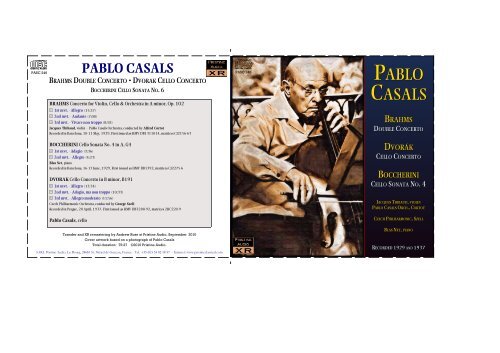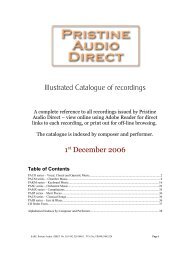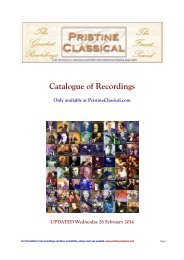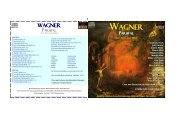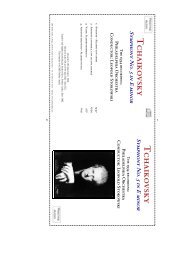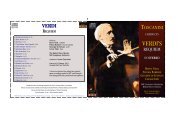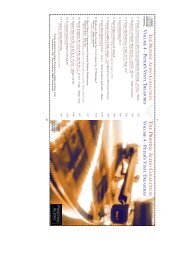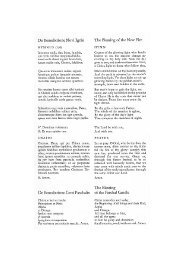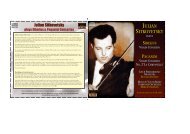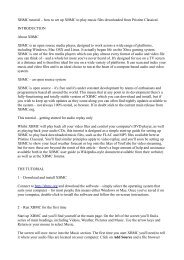PABLO CASALS - Pristine Classical
PABLO CASALS - Pristine Classical
PABLO CASALS - Pristine Classical
Create successful ePaper yourself
Turn your PDF publications into a flip-book with our unique Google optimized e-Paper software.
LPASC 246 PASC 246BRAHMS Concerto for Violin, Cello & Orchestra in A minor, Op. 1021 1st mvt. - Allegro (15:27)2 2nd mvt. - Andante (7:00)3 3rd mvt. - Vivace non troppo (8:58)Jacques Thibaud, violin - Pablo Casals Orchestra, conducted by Alfred CortotRecorded in Barcelona, 10-11 May, 1929. First issued as HMV DB1311014, matrices CJ2156-63BOCCHERINI Cello Sonata No. 4 in A, G44 1st mvt. - Adagio (3:36)5 2nd mvt. - Allegro (4:23)Blas Net, pianoRecorded in Barcelona, 16-17 June, 1929. First issued as HMV DB1392, matrices CJ2275-6DVORAK Cello Concerto in B minor, B1916 1st mvt. - Allegro (13:34)7 2nd mvt. - Adagio, ma non troppo (10:33)8 3rd mvt. - Allegro moderato (11:56)Czech Philharmonic Orchestra, conducted by George SzellRecorded in Prague, 28 April, 1937. First issued as HMV DB3288-92, matrices 2HC220-9Pablo Casals, cello<strong>PABLO</strong> <strong>CASALS</strong>BRAHMSDOUBLECONCERTOONCERTO • D• DVORAKCELLOCONCERTOBOCCHERINICELLOSONATANO. . 6Transfer and XR remastering by Andrew Rose at <strong>Pristine</strong> Audio, September 2010Cover artwork based on a photograph of Pablo CasalsTotal duration: 75:27 ©2010 <strong>Pristine</strong> Audio.SARL <strong>Pristine</strong> Audio, Le Bourg, 24610 St. Méard de Gurçon, France - Tel. +33 (0)5 53 82 18 57 - Internet: www.pristineclassical.comL<strong>PABLO</strong><strong>CASALS</strong>BRAHMSDOUBLECONCERTODVORÁKCELLOCONCERTOBOCCHERINIONATA NO. . 4CELLOSONATAJACQUESTHIBAUD, VIOLIN<strong>PABLO</strong><strong>CASALS</strong> ORCH., C ORTOTCZECH PHILHARMONIC, , S ZELLBLAS NET, PIANORECORDED1929 AND 1937
PASC 246<strong>CASALS</strong> PLAYS BRAHMS, DVORÁK AND BOCCHERINI<strong>PABLO</strong> <strong>CASALS</strong><strong>PABLO</strong> <strong>CASALS</strong>BRAHMSDOUBLECONCERTOONCERTO • D• DVORAKCELLOCONCERTOBOCCHERINICELLOSONATANO. . 6The major concerto recordings of Pablo Casals, in particular that of the Dvorák Cello Concerto of 1937, have been staples of theclassical catalogue ever since their original releases. At the time of writing there are several issues available in different transfers bydifferent labels, and it is surely fair, therefore, to ask why the world needs yet another transfer.LPASC 246The truth of the matter is that this release came out of an instance of pure curiosity on my part. I had received, in amongst a majorcollection of LP records, a vinyl transcription of the Dvorák on a white-label test pressing that appeared to have been barely, if ever,played. I confess I have no idea whether this transfer was released, and if so, when - it was simply to serve as a quick and easy means ofsubjecting the recording to an XR remastering test - I certainly was not expecting the results of this to merit issue.However, the LP transfer turned out to be much better than I had expected, and the XR remastering brought such new life to it that Idecided to persevere with it, needing only to drop in a couple of short sections from alternative sources where top-end quality was lessthan excellent. Sitting close by was another test pressing, this time the Boccherini Cello Concerto No 9 with Casals conducting andMaurice Gendron playing. Investigations suggested that this was the first time Boccherini's original - rather than Grützmacher'sbastardised version - had been recorded, and that it dated from 1958 but appeared since to have disappeared from the catalogue. I quicklygot to work on this stereo recording with the intention of partnering it with the Dvorák, only to discover at the last minute that theerudite and well-respected author of the notes from which I'd taken the recording date was out by a matter of two years, and that therecording itself would remain in copyright until 2012.Turning - in need of some other recording to add to this release - to the <strong>Pristine</strong> Audio collection of 78s, I dug out the older recording ofBrahm's Double Concerto. As it dates from 1929 my hopes were less high than for the Dvorák, but despite some noisier sides I wasextremely impressed with how these came out. The XR process not only opened out upper frequencies and harmonics beyond thosenormally heard, it also unleashed an unusually rich acoustic from the recording venue which had been somewhat squashed before.The Double Concerto recording contains clues as to why the XR process can be so successful in reviving older cello recordings - whereasthe cello's harmonics are generally quite well represented in the limited frequency range of 1929 recording equipment, there are pointswhere Thibaud's highest harmonics have a tendency to distort and thus produce a less pleasant sound. That said, it's still a remarkablyclear and balanced recording for its day, and now far clearer and cleaner than ever before.Finally, as a result of recent diligent cataloguing work of the darker recesses of our collection by our archivist, I discovered the Boccherinidisc tucked away in a large album of mixed 78s and in very good condition. As it was recorded in Barcelona shortly after the Brahms Idecided to add it to the concerto recordings as a kind of musical stepping stone between the larger works. Again the remastering processbrought out much clarity, warmth and a lovely reverberant acoustic to complement the instruments.NOTES BY ANDREW ROSE - FURTHER NOTES ONLINE AT WWW.PRISTINECLASSICAL.COM<strong>CASALS</strong> PLAYS BRAHMS, DVORÁK AND BOCCHERINI<strong>PABLO</strong> <strong>CASALS</strong>PASC 246


